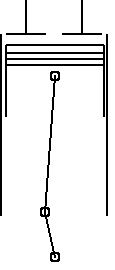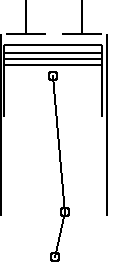|
|
Axial offset

Shortly before TDC
|

TDC exactly
|

Shortly after TDC
|
The picture on the left shows a slightly- and an exaggerated (on the right) axial offset. In the second picture you'll see that, through the shifting of the gudgeon pin, the right hand piston changes sides, before TDC. This is
the case with the left hand piston as well, only after TDC, i.e, in the area of increased combustion pressure.
Of course, the picture above on the right, shows a greater shift than actually takes place. Mostly, it can hardly be seen with the naked eye, perhaps approx. 1 mm. This however, at the same time, is also the danger. Should
one, when installing the piston/s, turn them around 180°, which is possible with some pistons, exactly the opposite is achieved. After the installation, the engine, which needs the offset, could sound like it was suffering
from piston damage.
| Axial offset helps to prevent cavitation (pitting) on the cylinder sleeve walls. |
Previously axial offset was used for the above described reasons. The mechanism for observing the processes in the cylinder area has now been refined. Perhaps the piston could simply be minimally tilted during the
pressure phase, to allow the rings to seal perfectly. Either that or the piston first makes contact with the shaft instead of with the ring-zone.
Apart from the axial offset, there is also the skewing. Thereby, the crankshaft is moved away from the center-axis of the piston movement. VR-engines can mostly not get by without skewing, because there is too little space
for the cylinders down in the cylinder-block. In certain circumstances an axial offset can compensate a little. Skewing is not only found in VR-engines. Toyota's three-cylinder e.g., is shifted 8 mm off-center to move the tilting
point so that the connecting rod and the crank-pin are as straight as possible at the point of the highest working pressure, thus losing as little power as possible from the friction between the piston and the cylinder sleeve.
05/12
|
|